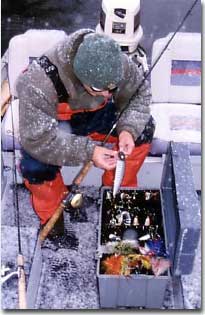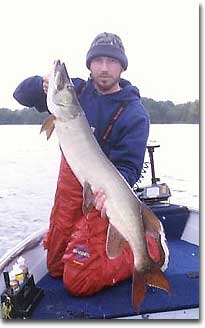A Desert Island Lure for Fall Muskies
A Desert Island Lure for Fall Muskies
By Justin Hoffman
 The period of fall has many bonus rewards for the angler willing to put in the time, and effort, to find and catch fish. It has proven itself to be the best time of year to do battle with the mighty muskie, and in terms of quantity and quality, this is definitely the time to begin your search. Although there are literally dozens of styles of baits to choose from when it comes to muskie fishing, the fall period simplifies the decision greatly. If I have to put my money on one lure that will consistently catch muskies during the fall, the choice would be easy - - the jerkbait would get the nod every day of the week. The period of fall has many bonus rewards for the angler willing to put in the time, and effort, to find and catch fish. It has proven itself to be the best time of year to do battle with the mighty muskie, and in terms of quantity and quality, this is definitely the time to begin your search. Although there are literally dozens of styles of baits to choose from when it comes to muskie fishing, the fall period simplifies the decision greatly. If I have to put my money on one lure that will consistently catch muskies during the fall, the choice would be easy - - the jerkbait would get the nod every day of the week. The Lure As the water in the fall cools, an impulse is triggered in the muskie to start feeding heavily in order to store reserves to get through the cold winter months. Muskies feed voraciously at this time, yet, as the water cools, the fishes metabolism slows down, which means they will not chase a fast moving bait as they would in the summer. This is where the choice of a jerkbait really shines through. A jerkbait is a wood or plastic lure that relies on the angler to impart the bait’s action through the use of “sweeps” or “jerks” on the rod. This motion causes the bait to dive down and then slowly rise back up. It mimics a wounded baitfish precisely, and also has the correct speed and tempo that causes the opportunistic muskie to strike. Tackle store shelves are filled with a large assortment of different styles and types of jerkbaits – all possessing a different look and action. A few to keep an eye out for is the Suick, Jake and the Reef Hawg. After spending many days during the fall chasing the mighty muskie, it has occurred to me that approximately 90% percent of my casting is done with a jerkbait, and for good reason. The lure has a big profile in the water that attracts the attention of hungry fish – and BIG fish. Most sport three large and sturdy trebles that hook and hold extremely well. Under most conditions jerkbaits will dive from a depth of two to six-feet, and will slowly rise back to the surface. The one mistake I see a lot of anglers making is letting the jerkbait rise completely to the surface before jerking it down again, which is, unfortunately, keeping the lure out of the strike zone fifty-percent of the time. Where To Begin Your Search During the fall you can usually find muskies in very specific locations. The one common ingredient to look for when searching for fish is the presence of green weeds. At this time of year, baitfish will be keying in on these oxygen-rich plants; this in turn will bring in the larger predators. When casting jerkbaits in the fall, I usually search out water in the 5-to-twelve-foot-depth, with some sort of structure the fish can key in on. Keep an eye out for weedlines that have definite edges and ambush spots for the muskie to hide in. Other areas to try out would be points of islands and anywhere you can find a weed-rock transition area.  As fall progresses, and water temperatures continue to plummet, your best bet is to seek out the next available deeper water that is close to where you found fish earlier in the fall. Basically this means moving outward from early productive spots until the next, or secondary weedline, is found. Generally this water will be a few feet deeper and will congregate the majority of fish. I find that this pattern is viable right up to the end of the season, as long as green, healthy plants are present. As fall progresses, and water temperatures continue to plummet, your best bet is to seek out the next available deeper water that is close to where you found fish earlier in the fall. Basically this means moving outward from early productive spots until the next, or secondary weedline, is found. Generally this water will be a few feet deeper and will congregate the majority of fish. I find that this pattern is viable right up to the end of the season, as long as green, healthy plants are present. Tools of the Trade Casting heavy jerkbaits all day will require some specialized equipment in order to get the job done right with the least amount of fatigue put on the body. I prefer a heavy-action muskie casting rod that is 6 feet in length. A rod of this length enables you to work the jerkbait precisely, and is stout enough to absorb hooksets and runs from a large fish. The choice of line is basically a personal choice, be it monofilament or dacron, or one of the new “superlines.” If you’re choosing monofiliment, make sure that it is at least 30-pound-test strength. A leader is the last requirement needed for a successful muskie hunt for a number of different reasons. Since muskies have razor-sharp teeth, the leader is necessary to guard against being bit off. They are also useful for when fish roll in the line during the fight, which most seem to do, as they won’t get cut on the gill-rakers. Choose a high-quality leader with at least an eighty-pound-test-strength rating to it, one that is between eighteen and twenty-four-inches and colored black for better concealment. Pick up a jerkbait this fall and head to your favorite lake, and experience how exciting and rewarding fall muskie fishing can be. And even though you might need a toque some days, and your fingers may get a little numb, all of that will be forgotten when that fat-bodied ‘ski plays tug-of-war on the end of your line!
|
